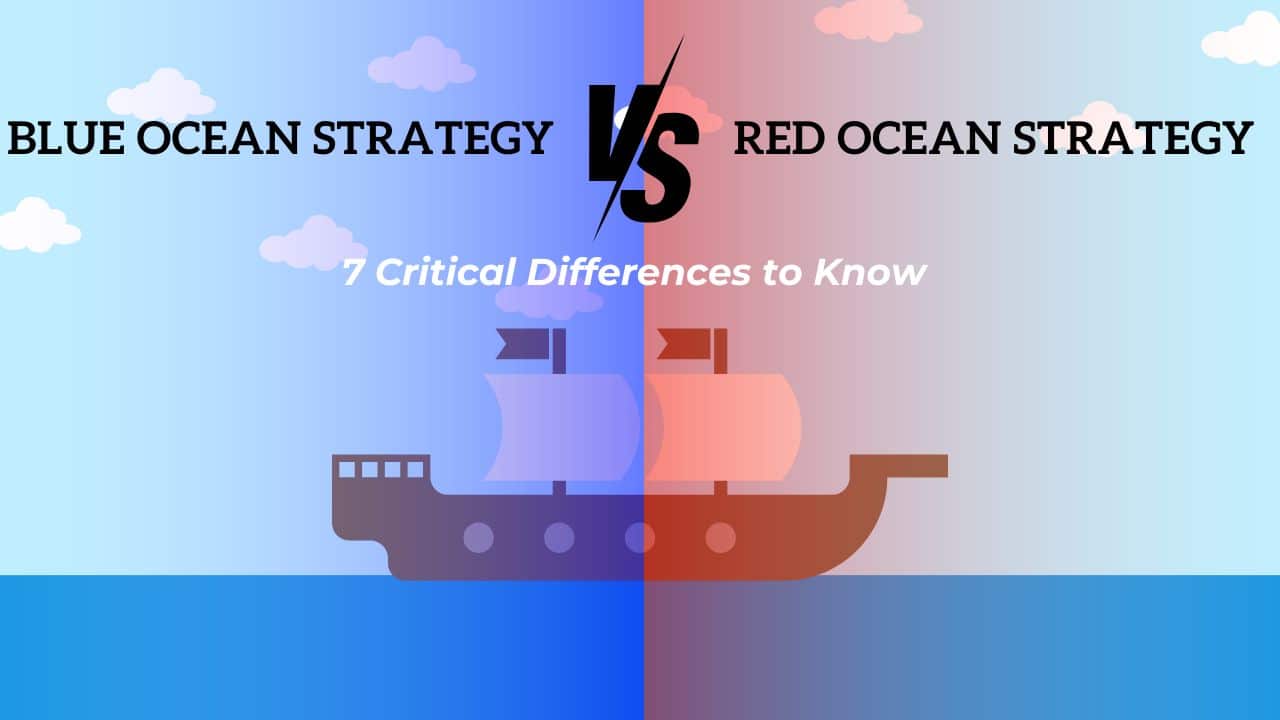With a captivating strategy, businesses are more likely to achieve long-lasting success in the ever-competitive world. Among the several other popular strategies are Red Ocean Strategy and Blue Ocean Strategy. Introduced by W. Chan Kim and Renee Mauborgne in 2004, the strategy’s motive was to establish your part of shares instead of fighting for your own.
In this guide, we have mentioned everything you should know about the Blue Ocean Strategy and Red Ocean Strategy, detailed real examples, and how to include these innovative strategies in this communication.
What is the Red Ocean Strategy?
One of the traditional business strategies, the “red ocean strategy” is when an organisation/company try to compete with their entrant to capture a larger market share. Meanwhile, in “The Red Ocean” the context implies a metaphorical situation wherein competitors are engaged in a war battle for a common customer base. Although it is obvious, the Red Ocean Strategy has several advantages,
Benefits:
- Participate in the ongoing market
- Competes against the rival organisation
- Takes advantage of the current demand
- Details a comparison between value and cost
- Manages a company’s entire functional system with its affordable and accurate strategy choice
How Does a Red Ocean Strategy Function?
For debuting in a market that is already aligned with a red ocean strategy, you have to introduce a market disruption. Meanwhile, that can be done by introducing a brand new product/service in the market that stands out as one of the unique services available in the market. With the uniqueness, you will be able to attract a majority of customers to your brand.
For Instance: Jio, the Indian telecommunications company, owned by Multi-billionaire Mukesh Ambani, made a market stir by offering free services that shook the entire telecom market.
By outperforming the competition by maximising the value, your company can withstand any newly introduced services.
Another instance is McDonald’s, the multinational food and beverages company, that runs under the motive of staying under the radar while providing substantial gains in customers with their affordable burgers.
Also Read – Financial Services Ease: How to Transfer Money From Chime to Cash App?
What is the Blue Ocean Strategy?
On the contrary, the Blue Ocean Strategy is to describe a new market with minimum rivals and competition standing in the way of innovators. Besides, in this strategy, the metaphor “Blue” implies the open vast options of the market become available when a new market debuts in a field.
Introduced by W. Chan Kim and Renee Mauborgne, primarily the term was coined in their book “Blue Ocean Strategy: How to Create Uncontested Market Space and Make the Competition Irrelevant?”
Benefits
- Originates From Proven Data
- With an immaterial competition, the aim is to redraw an industry’s boundaries
- Provides With Value and Affordability
- Provides a Vast framework for Companies to test their ideas
How Does a Blue Ocean Strategy Function?
With no option between value and affordability for customers, Blue Ocean’s primary focus is to generate updated value for clients.
For Instance: Facebook, which made its debut in 2004, was one of the few platforms to connect people through social media. Less than two decades after its debut, Mark Zuckerberg decided to rebrand the platform from “Facebook” to “Meta.” Additionally, now Meta’s accessibility has been extended to the “Metaverse.” With this decision, Facebook has influentially shifted from “Red Ocean Startegy” to “Blue Ocean Startegy.”

Red Ocean Strategy Vs Blue Ocean Strategy: Listing the Differences
Along with the metaphor, these two contexts have major comparisons. They are;
| Points of Comparison | Red Ocean Strategy | Blue Ocean Strategy |
| Competition | Higher amount of Competition | The lower range of competition |
| Focus | With the red ocean strategy, organisations are expected to fight the competition with existing services | With the blue ocean strategy, organisations can debut new services emphasising the minimum focus on competition |
| Market Space | Fights in the existing space and with the available service to a bigger rivalry field | Makes a new market space with innovative and new products |
| Customer Value | Competes with its rivals for the existing customer base | Attracts and generate new customers with their brand new product or services |
| Risk | Possesses a higher level of risks | Possesses a lower level of risks |
| Marketing Strategy/Approach | Features a positive, and future-oriented strategy prioritising more growth and opportunities | Features a negative and its primary motive is to defeat its rival organisation |
| Instances | In the era when smartphones were gaining popularity, Apple introduced iPhones attracting a chunk of customers | Coca-Cola’s and Pepsi’s cut-throat competition in the cola market, fighting for a share of the market |
Conclusion
When planning an impactful strategy for increasing the valuation of your business, the Red Ocean Strategy and Blue Ocean strategy can be game-changers for your organisation. While each one has its advantages and disadvantages, choose an appropriate strategy to make sure that you unlock a higher level of success. Besides, if you are looking for a clear explanation of and red ocean strategy and blue ocean strategy meaning, you can refer to our article.




